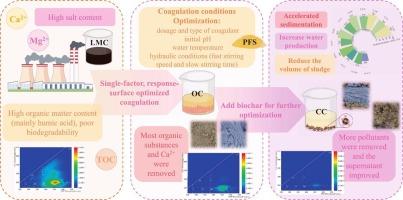Removal of total organic carbon and calcium ions from leachate membrane concentrate through polyferric sulfate coagulation enhanced with biochar
IF 4.3
2区 工程技术
Q2 ENGINEERING, CHEMICAL
引用次数: 0
Abstract
With the development of industrialization and urbanization processes, a large amount of leachate membrane concentrate (LMC) with poor biodegradability, high organic pollutants and salt content has been generated. Previous studies often struggled to balance treatment effectiveness with operational costs or caused secondary pollution. In this study, polyferric sulfate (PFS) was selected for the coagulation treatment of LMC with Box-Behnken Design (BBD) experiments as optimization and then enhanced with wheat dust biochar (WDB) to solve the above problems. The optimized conditions were a pH of 5.9, a PFS dosage of 4.8 g/L, a water temperature of 19.9 °C, a rapid stirring speed of 400 rpm, and a slow stirring time of 15 min, achieving a total organic carbon (TOC) removal rate of 75.20 % with corresponding reductions in other pollutant indicators. When biochar was added, the TOC, ammonium nitrogen (NH4+-N) and Ca2+ removal rates increased to 81.36 %, 82.85 % and 90.23 %, respectively. The chroma and turbidity were also significantly reduced. Moreover, adding biochar increased the sedimentation rate to 3.75 times the original rate, reduced sludge volume and improved water yield, leading to cost savings. Overall, this method is simple to operate and environmentally friendly, offering both effective treatment and economic benefits and holding practical significance for engineering applications and resource recovery.

生物炭强化聚合硫酸铁混凝去除渗滤液膜浓缩液中总有机碳和钙离子
随着工业化和城市化进程的发展,产生了大量可生物降解性差、有机污染物和含盐量高的滤膜浓缩液(LMC)。以前的研究往往难以平衡处理效果与运营成本,或造成二次污染。本研究采用Box-Behnken设计(BBD)实验优化聚合硫酸铁(PFS)对LMC进行混凝处理,再添加小麦粉生物炭(WDB)进行强化处理,以解决上述问题。优化条件为pH = 5.9, PFS投加量为4.8 g/L,水温为19.9 °C,快速搅拌速度为400 rpm,慢速搅拌时间为15 min,总有机碳(TOC)去除率为75.20 %,其他污染物指标相应降低。添加生物炭后,TOC、铵态氮(NH4+-N)和Ca2+的去除率分别提高到81.36 %、82.85 %和90.23 %。色度和浊度也显著降低。此外,添加生物炭使沉降速率提高到原来的3.75倍,污泥体积减少,产水量提高,从而节省了成本。总的来说,该方法操作简单,环境友好,既具有有效的治理效果,又具有经济效益,对工程应用和资源回收具有现实意义。
本文章由计算机程序翻译,如有差异,请以英文原文为准。
求助全文
约1分钟内获得全文
求助全文
来源期刊

Chemical Engineering Science
工程技术-工程:化工
CiteScore
7.50
自引率
8.50%
发文量
1025
审稿时长
50 days
期刊介绍:
Chemical engineering enables the transformation of natural resources and energy into useful products for society. It draws on and applies natural sciences, mathematics and economics, and has developed fundamental engineering science that underpins the discipline.
Chemical Engineering Science (CES) has been publishing papers on the fundamentals of chemical engineering since 1951. CES is the platform where the most significant advances in the discipline have ever since been published. Chemical Engineering Science has accompanied and sustained chemical engineering through its development into the vibrant and broad scientific discipline it is today.
 求助内容:
求助内容: 应助结果提醒方式:
应助结果提醒方式:


